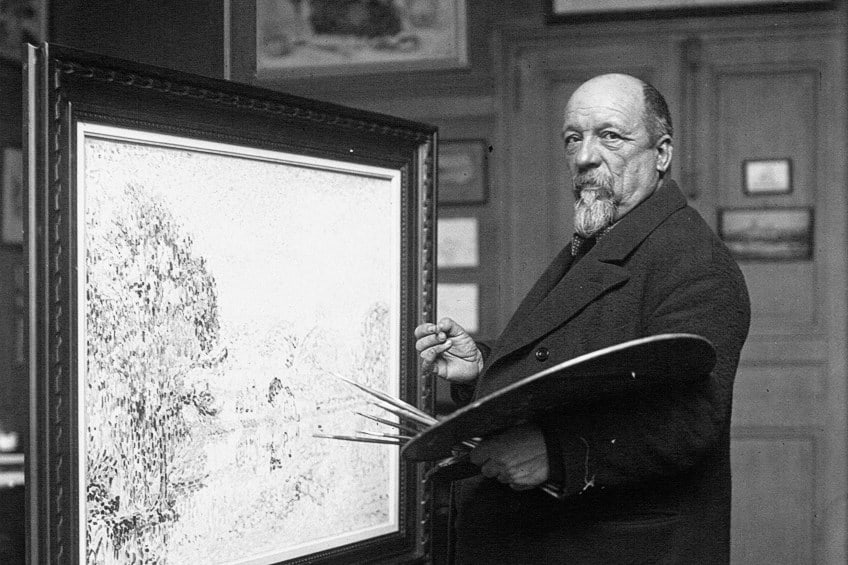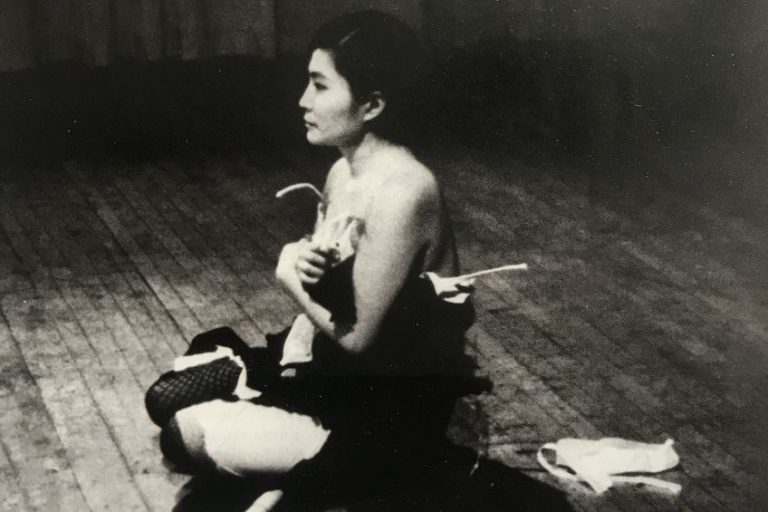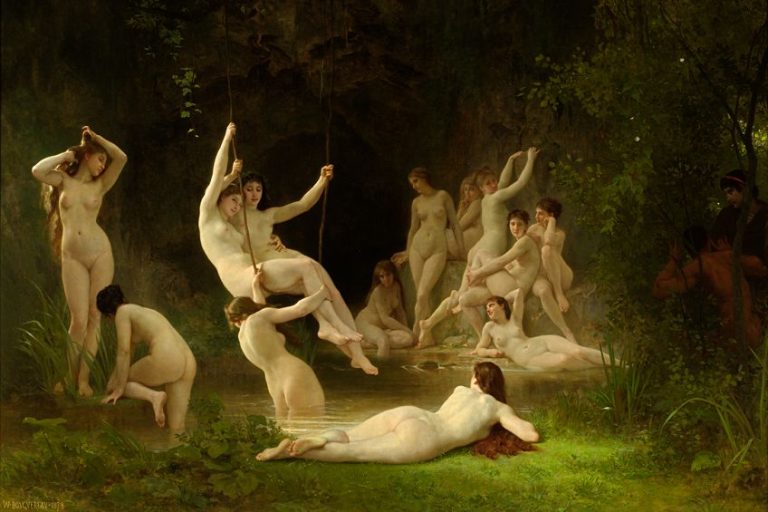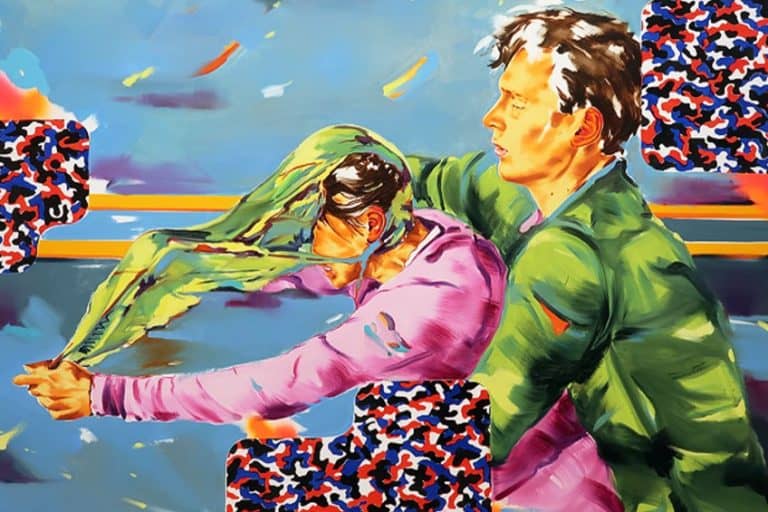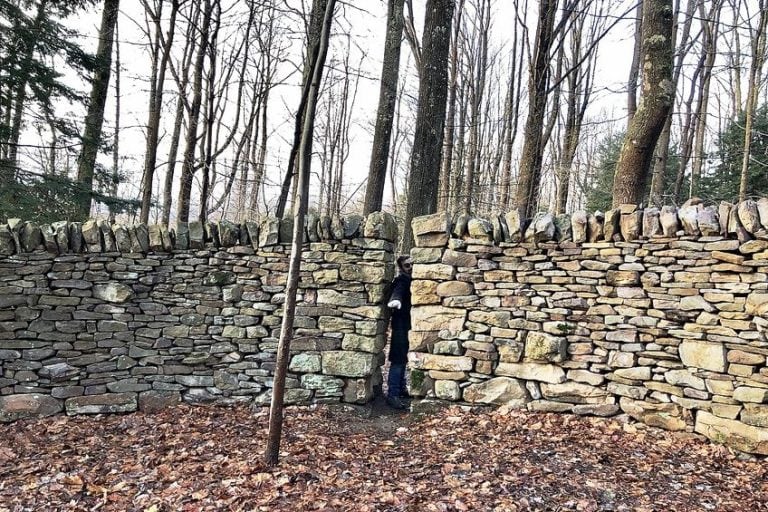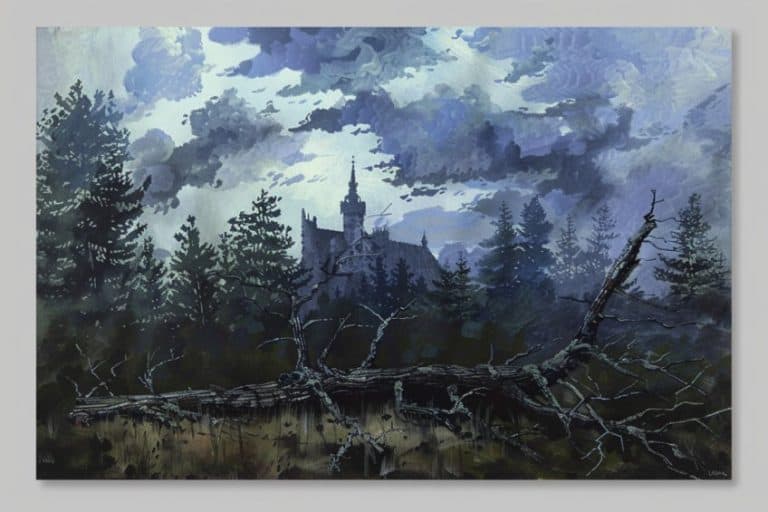Paul Signac – Multi-Media Artist and Pioneer of Pointillism
Paul Signac the artist, who was both well-educated and intelligent, was profoundly affected by current optical and chromatic concepts, as well as the works of the Impressionists, who were at the forefront of creative innovation when he was a youngster. The style of Paul Signac’s paintings evolved significantly as he embraced Pointillism methods and concepts established in partnership with Georges Seurat. The earlier Impressionist style’s quick, variable brushstrokes, meant to represent the impact of light on items, were modified into the tiny dots of Paul Signac’s Pointillism.
Paul Signac’s Biography
| Nationality | French |
| Date of Birth | 11 November 1863 |
| Date of Death | 15 August 1935 |
| Place of Birth | Paris, France |
Paul Signac the artist and other Neo-Impressionists took the first steps in Modernism by stripping down the essential elements of a work, removing color from the items it portrayed – a crucial step toward greater abstraction by later painters. Paul Signac was a pioneer in his vast exploration of a number of media, from printmaking methods such as etching and lithography to watercolor, including meticulous drawings for canvases rendered in tiny dots.
He consistently constructed shapes without depending on the line, imposing a consistent degree of abstraction on all of his works, irrespective of the chosen media.
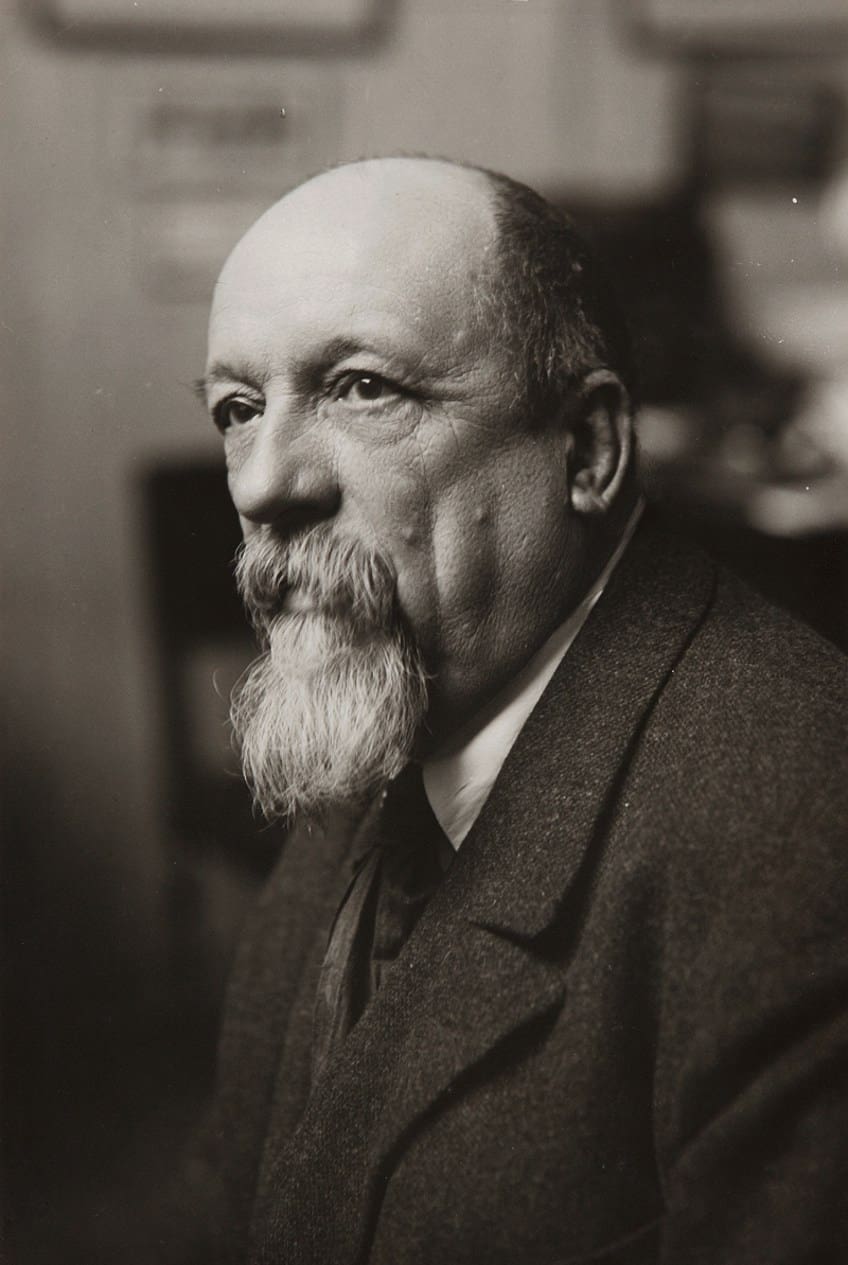
Childhood and Education
Paul Signac was born in the late 19th century in Paris, amid the crucial last years of the development of Modernism. Early in his youth, his family moved to the Montmartre neighborhood of Paris, which was then a bustling cultural community. The shift had a significant influence on Signac’s early involvement with the visual arts and, more broadly, with avant-garde society.
In his adolescence, Signac was fascinated by the works of the Impressionists, who were at the forefront of creative progress at the time. His fairly liberal family urged him to attend exhibits and acquire the aesthetics of Impressionism.
When Signac was around 16 years of age, he went to the sixth Impressionist exhibition in 1881, where he was strongly influenced by Claude Monet’s art. He was drawing a copy of an Edgar Degas painting when he was challenged by a harsh, angry Paul Gauguin who said, “One does not duplicate here, gentleman!” and was kicked out of the exhibition.
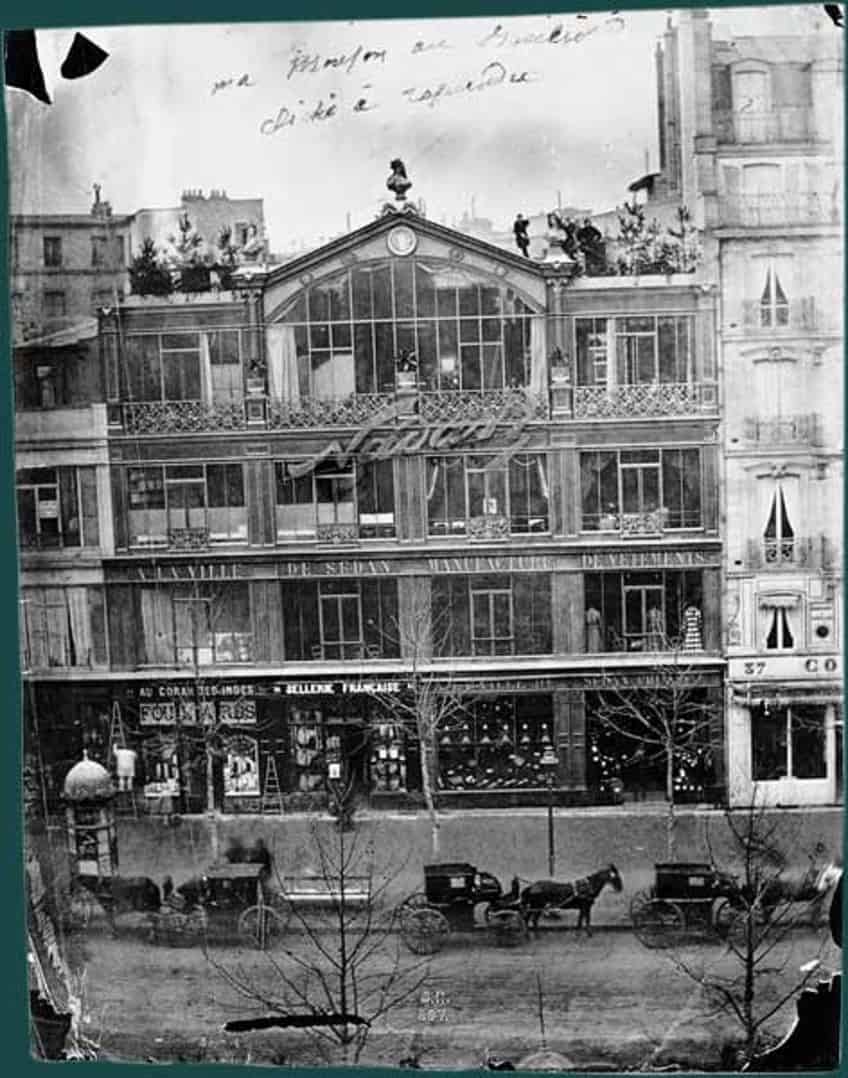
Signac’s loving father died of TB in 1880. Upon his father’s passing, his mother chose to sell the family company and go to Asnières, a new Parisian neighborhood. Dissatisfied with his new surroundings, Signac dropped out of school and relocated to Montmartre, where he leased a room and split his days between Asnières and Paris. Signac socialized around Montmartre, spending time at prominent locations such as the iconic cabaret, Le Chat Noir, which he started regularly visiting in 1881.
He met artists, authors, performers, and other artistic movers and shakers through the Parisian nightlife scene as well as more specific channels like avant-garde literary societies.
He frequented Naturalist writers’ gatherings, for example, at the well-known Brasserie Gambrinus and at the houses of authors such as Robert Chase. On such an occasion, he became acquaintances with critics Félix Fénéon and Gustave Kahn. Many of the authors and reviewers he met in those early years ultimately became staunch fans of his works and style.

Signac’s involvement with avant-garde literary societies wasn’t only about interacting with creative types; he was also a talented writer, having written several sarcastic pieces on his hero, Zola’s occasionally “ponderous” manner in 1882. Signac proceeded to tour exhibitions throughout the early 1880s, and later attributed a particular show in June 1880, a showcase of creations by Monet as being a crucial influence in his choice to undertake a career in art – particularly as a painter.
He appreciated not just Monet’s Impressionist technique, but also his extremely common topics – mostly paintings done en plein air, in the wide outdoors, and portraying even the most mundane situations.
Early Career
The earliest of Paul Signac’s paintings come from the winter of 1881 to 1882, when he was just 18 years old. Signac was almost entirely self-taught, save from some basic tuition at the workshop of portraitist and historical painter Émile Bin, which was provided at no cost. He absorbed himself in the works of famous Impressionists such as Manet, Monet, Caillebotte, and Degas. Signac’s images of Port-en-Bessin from 1883 reveal the impact of pieces he had viewed in Monet’s exhibit in a studio on the Boulevard de la Madeleine that March.
At that moment, the young self-taught artist had completely embraced the Impressionist aesthetic.
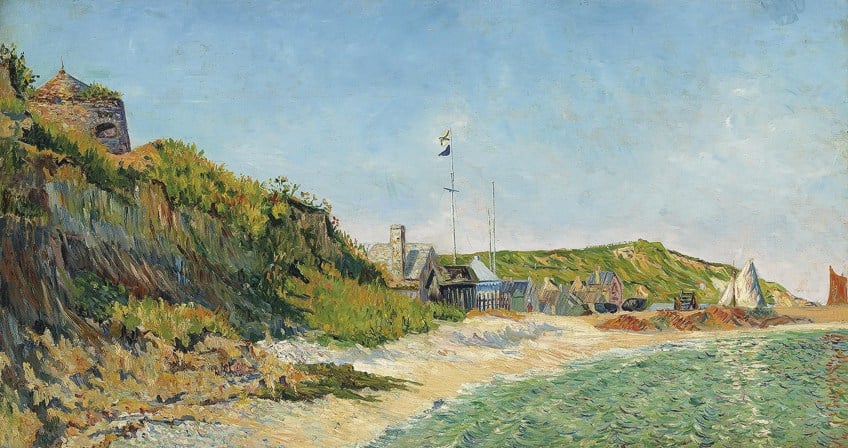
By 1884, Signac had evolved sufficiently as an artist to submit several of his paintings in the inaugural Salon des Artistes Indépendants, which was supported by the newly created avant-garde painters’ organization of which he was a founder member together with Albert Dubois-Pillet and Odilon Redon. Georges Seurat’s art was also on show. The two artists are reported to have first met at that time.
Future Neo-Impressionists Henri Edmond Cross, Dubois-Pillet, and Charles Angrand also had artworks in the breakthrough show. The ties developed at the 1884 show proved crucial.
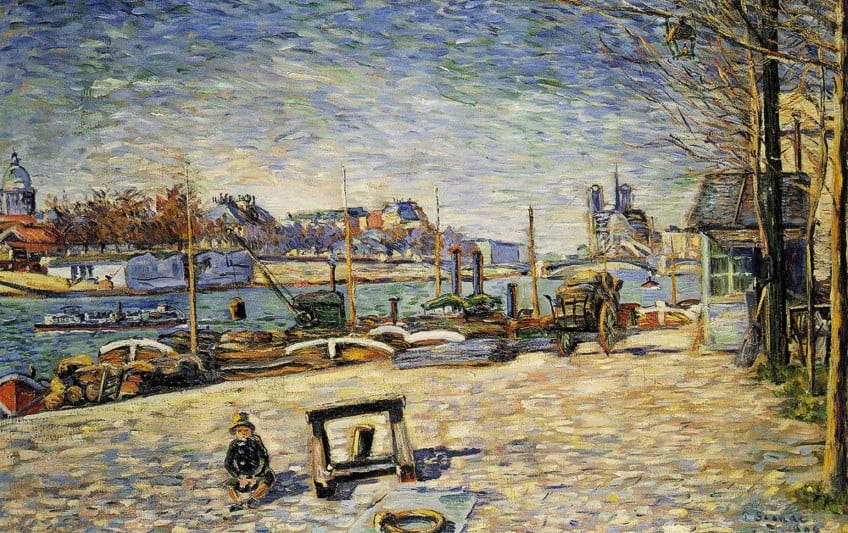
In addition, throughout the next three decades, the Société was a key force in exposing avant-garde creative trends through its yearly exhibits. These shows, unlike the official Salon, did not issue prizes. Instead, its credo was “to provide artists entire freedom to exhibit their creations to public judgment.”
Collaborations
Signac encountered Impressionist painter Armand Guillaumin in 1884, and Camille Pissarro the next year, in 1885. Both of those well-known Impressionist artists gave Signac advice and support, but the impact of Seurat, whose works he adored, had not yet started to show in his paintings.
Signac, on the other hand, had started interacting with Seurat on a routine basis, and both artists shared curiosity about Michel-Eugène Chevreul’s color theories as well as contemporary ideas about optics, notably in connection to the arts.

Furthermore, one of the most prominent causes motivating the Neo-Impressionist method was Charles Henry’s 1885 essay, Introducing a Scientific Aesthetic, which “contended for an art founded on scientific methodology.” By December of 1885, Signac and the rest of the ensemble had established their distinct aesthetic – Neo-Impressionism. Both Seurat and Signac were chosen to display their works, all in a new manner, at the eighth and last Impressionist show, despite opposition from Édouard Manet’s brother and Degas.
Despite this opposition, the two presented their work with a favorable critical reception.

Meanwhile, they had established not just a good business connection but also a strong friendship. Signac was Seurat’s closest collaborator and Neo-finest Impressionism’s propagandist and memorialist. While Seurat was a recluse, the extroverted Signac was a visionary as well as a type of social director for the emerging aesthetic.
He exposed Seurat to Impressionist and Symbolist artists. In return, the youthful and mostly unskilled Signac profited from his elder colleague’s training.
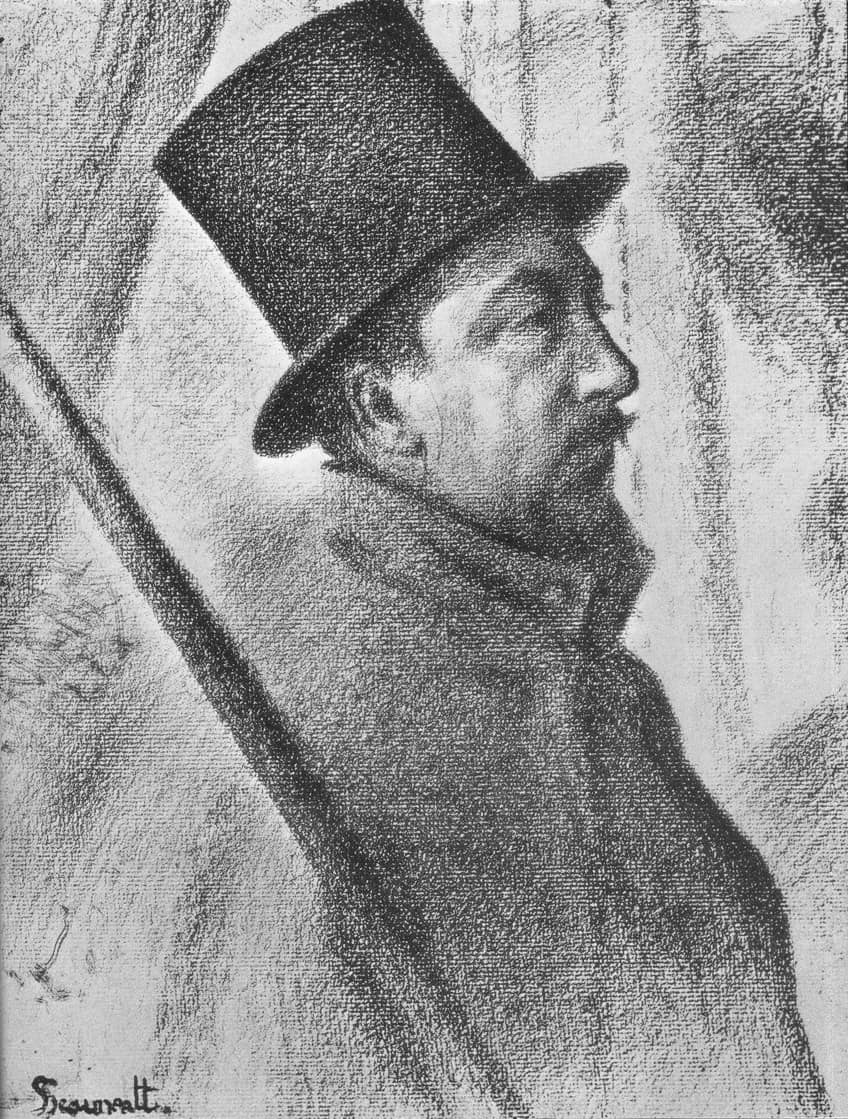
Mature Period
In 1886, Signac encountered Vincent van Gogh in Paris, and the two painters began a pleasant working relationship, regularly visiting locations such as Asnières to paint both interior and exterior vistas. Van Gogh was obviously taken with Signac’s free brushwork. In 1889, Signac visited Van Gogh in Arles and showed him how to create in the Neo-Impressionist manner.
Signac was also a political activist.
In 1888, he became engrossed in anarchism, notably Jean Grave’s beliefs, among others. Signac made monthly financial donations to Grave’s anarchist-communist periodical with Pissarro and two other acquaintances, Angrand Cross and Maximilien Luce.
His art and political convictions frequently collided, like in the piece titled In the Time of Harmony (1893), authorities were targeting anarchists at the period, so Signac was obliged to alter his name or face possible prosecution.
Seurat died in 1891, bringing an end to a nearly decade-long partnership between the two painters. While Signac proceeded to work in the Neo-Impressionist manner after Seurat’s passing, his brushwork grew looser, more emotive, and vibrant.
In November of 1892, Signac wedded Berthe Roblès, a longstanding lover; the two were betrothed in Montmartre, with Luce and Pissarro among the witnesses. The couple relocated to a condominium in the famed Castel Beranger in 1897. In the same year, he purchased a home in Saint-Tropez, France. Signac built a huge studio in the Saint-Tropez mansion, which he finished late in the summer of 1898.
It was there that the artist created some of his most vibrant and well-known Neo-Impressionist works, including paintings of beaches, boats, and seascapes.

As he became older, Signac’s rate of artistic output didn’t slow down. He was still doing work in the early 20th century, whether it was oil paintings, watercolors, or sketches. Signac believed that to live was to paint, and that to create was to live.
He never stopped creating art, starting a new set of canvases of French ports in 1929.
Signac died of septicemia on the 15th of August, 1935, and is buried in the famed Pere Lachaise cemetery in Paris. Signac is recognized with a number of fundamental works on art theory, a book on Dutch artist Johan Barthold Jongkind, and several articles for exhibition catalogs.

Paul Signac’s Paintings
Now that we have covered Paul Signac’s biography, we can turn to examples of Paul Signac’s Pointillism and Neo-Impressionism. In some aspects, Signac’s work reflects his claimed enthusiasm for Naturalism, notably in literature, as seen by his near idolization of Émile Zola.
His attention to optical mechanics and color theories particularly places him among a generation of artists who explored ways to innovate by adopting a scientific attitude to aesthetics.
Paul Signac the artists utilized a method that required laying dots of pure color on the canvas individually and letting the spectator’s eye mix the paint, which occurred when the observer stood back at least a couple of meters from the picture.
The Milliners (1886)
| Date Completed | 1886 |
| Medium | Oil on canvas |
| Dimensions | 81 cm x 100 cm |
| Current Location | Emil Bührle Collection, Zürich |
Paul Signac’s first significant interior scene depicts a topic that the Impressionists, such as Cassatt and Degas, frequently depicted. Berthe Roblès, his partner and eventual wife, was also a milliner. Berthe posed for this piece: she’s the woman on the left, reaching for her scissors. The action takes place at a milliner’s workplace in the Sentier neighborhood of Paris, which is still the city’s garment sector.
The term was originally related to specific roles played by the characters in the piece, such as “trimmer” and “finisher.” This demonstrates Signac’s unwavering commitment to accuracy.
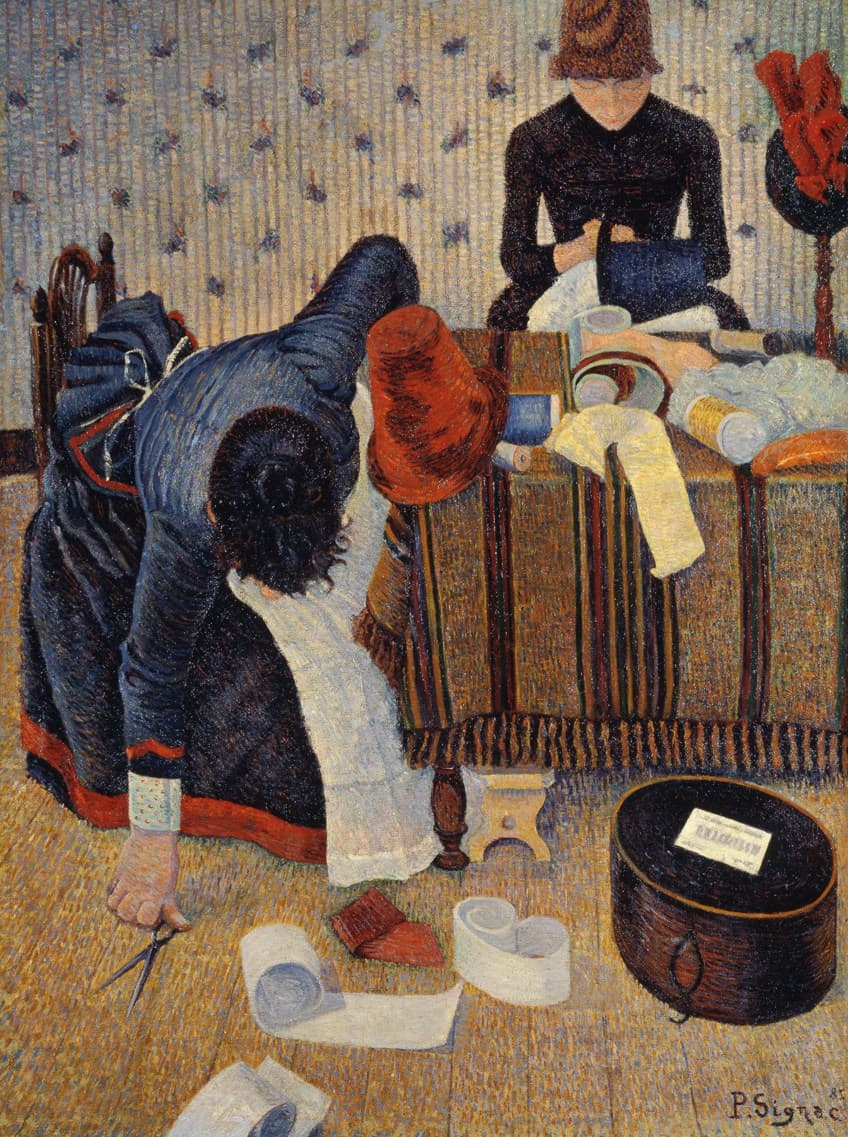
Berthe had provided him with a plethora of knowledge about millinery and its specific language, which he needed in order to create a work that went beyond just visual documentation. Signac studied working-class women and, in a sense, enhanced their status via his works, similar to Impressionist artists such as Degas, who regularly depicted them. This artwork is from the early Neo-Impressionism period, and it was really started and then modified in the growing Pointillist style.
This artwork is from the early Neo-Impressionism period, and it was really started and then modified in the growing Pointillist style.
The mostly self-taught Signac is still dealing with the delineation of fictive space in this early piece. The milliners’ workshop is fairly small, accentuating the sense of closeness and connection. Furthermore, the surface does not shine as it would in his works even a year later at this initial step in the formation of Neo-Impressionism.
Les Andelys (“The Riverbank”) (1886)
| Date Completed | 1886 |
| Medium | Oil on canvas |
| Dimensions | 65 cm x 80 cm |
| Current Location | Musée d’Orsay, Paris |
In terms of Signac’s style, the tremendous influence of Impressionism still exercised great force when he created this piece. The quick brushstrokes and realistic palette of Impressionist paintings are shown in this artwork, which was created in Les Andelys, on the riverbank of the Seine River. Lighting, as it blinks in the sky and on the waters, is given the respect it deserves in an Art piece, as evidenced in works by Pissarro and Monet, both of whom mentored (almost indirectly taught) the self-taught Signac.
In the summer of 1886, Signac spent a formative period in the little hamlet of Les Andelys, where he created 10 landscapes using the Neo-Impressionist method that he was honing in conjunction with Georges Seurat.

This picture, along with three others from the series, was shown at the Salon des Artistes Indépendants in 1887. It depicted a peaceful image of village life on the river that also ran through the bustling capital city of Paris.
Signac’s works were praised by notable reviewers like Paul Alexis, Gustave Kahn, and Félix Fénéon. “Mr. Signac’s energy highlights the brilliant contrasts in his recent canvases,” Fénéon commented.
“It is the dazzle of the noon sun which is captured in these scenes; of all those that we know, they are the most thoroughly imbued with the pleasure of things and shown with the wonderful effects of light,” Kahn said of the artist’s superb representation of light.
Lady on the Terrace (1898)
| Date Completed | 1898 |
| Medium | Oil on canvas |
| Dimensions | 72 cm x 91 cm |
| Current Location | National Gallery of Ireland |
By 1898, when Signac created this painting in his Saint-Tropez studio, his Neo-Impressionism style had matured from his early 1880s experimental phase. Signac, who was known for producing several preliminary drawings, often in color, before commencing a painting, prepared several sketches for the piece.
The dots of his Neo-Impressionist approach have become bigger in contrast to early works, while they are still meticulous and restrained, and his palette is significantly less somber.
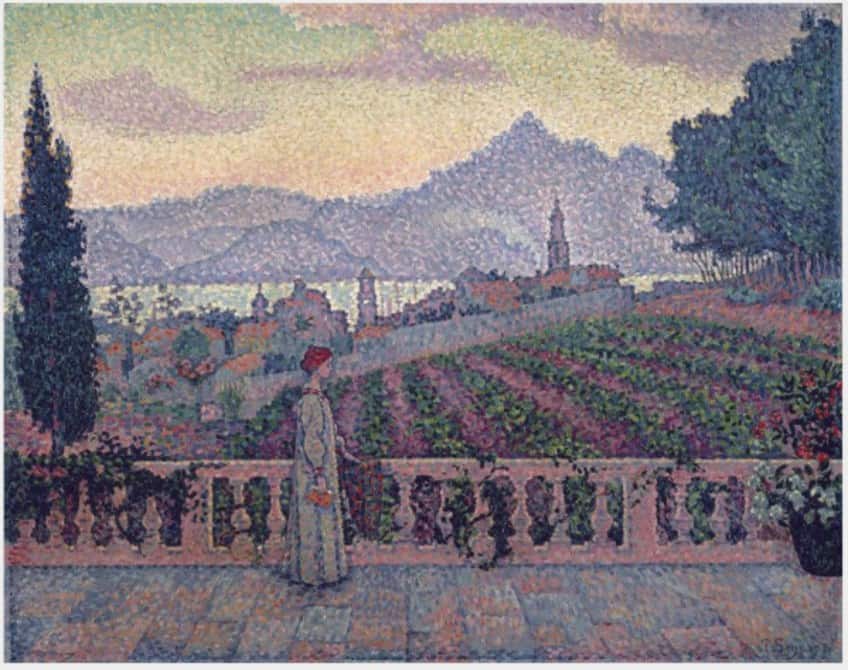
Retreating streaks of color on the patio and sea, carry the eye from the small foreground area towards the mountains in the distance. His wife, Berthe, served as the basis for the feminine figure, which is an assertive vertical to the strong horizontal of the patio and so on. The towers and trees in this beautifully painted recollection of a magnificent sunset on the French Riviera mimic her verticality.
There is a sense of calm and equilibrium in this skillfully created reminder of a beautiful view on the French Riviera.
Book Recommendations
Today we covered Paul Signac’s biography, as well as Paul Signac’s paintings. However, there is even more to discover about Paul Signac the artist. Here are some good books that we can recommend to you to learn more about Paul Signac’s Pointillism technique and lifetime.
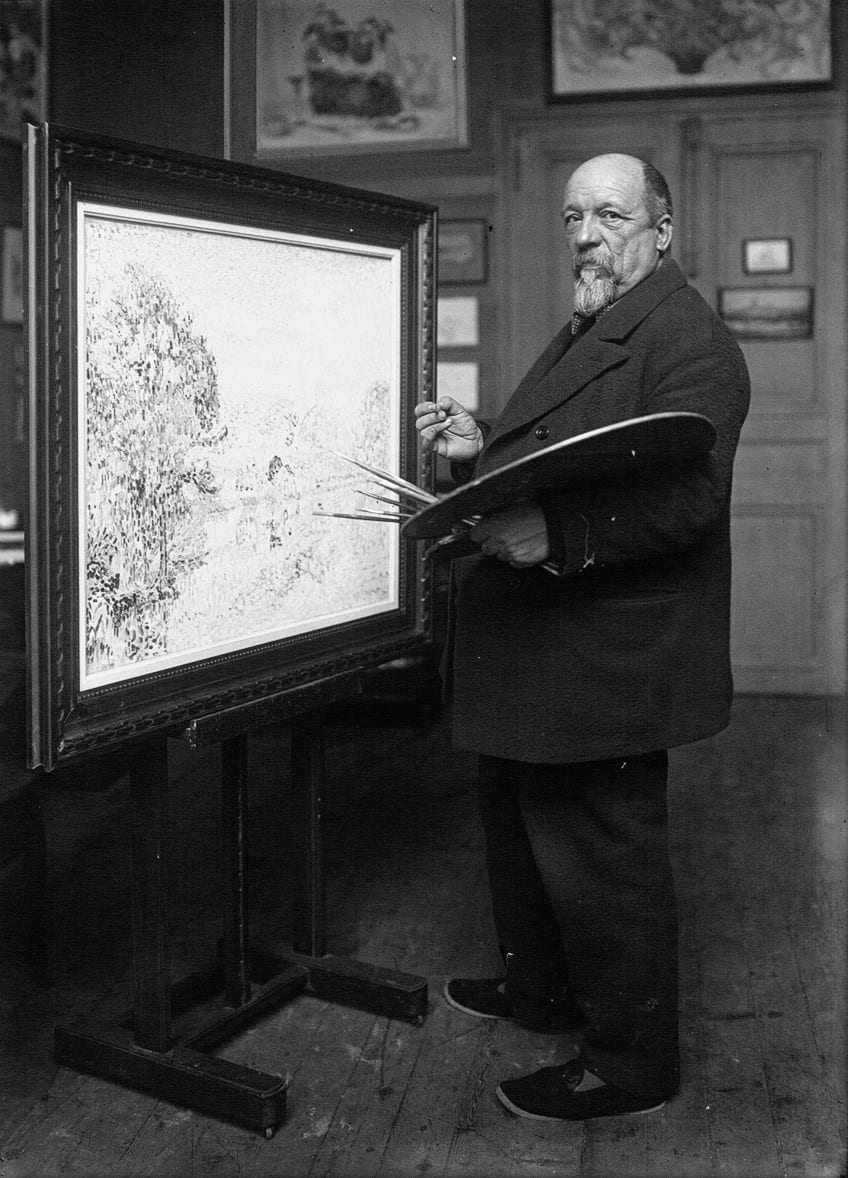
Paul Signac (2013) by Paul Signac
Paul Signac was a colleague and follower of Georges Seurat, who merged the technical accuracy of pointillism with the vibrant colors and emotive articulation of Impressionism. He was influenced by Monet’s works at an early age. Signac traversed the globe in pursuit of ideas for his mammoth works and was a close confidant of Vincent van Gogh, who was a huge fan of his skills.
This book delves into the complexities of Signac’s renowned technique while also highlighting the subtleties of some of his most well-known works.
- Examines the intricacies of Signac’s celebrated painting technique
- Analyzes how Signac combined Pointillism with Impressionism
- Showcases the details of some of Signac's most celebrated works
Signac: Reflections on Water (2017) by Sylvie Wuhrmann
This catalog provides an introduction to Paul Signac’s color harmonies as well as a vacation invitation. Paul Signac’s career as a color-loving artist was as diverse as it was fierce. This publication highlights the artist’s creative path from his early paintings to his final watercolors, starting with one of the greatest personal collections of the creator’s paintings.
Paul Signac the artist created strong works in a variety of mediums over the course of his 50-year career. His artistic advancement started with his luminescent plein air works of art in the early 1880s, proceeded with his experimentations of color balance and Neo-Impressionist methodology, and is intimately associated with Georges Seurat. It culminated with his fascinating mature works, in which the trials and tribulations of pointillism give rise to lushly designed, elegant color surfaces.
Frequently Asked Questions
What Was Unique About Paul Signac’s Paintings?
Signac experimented with a variety of mediums. He created lithographs, etchings, and many drawings formed of small, painstaking dots in addition to watercolors and oil paintings. The neo-impressionists impacted the upcoming generation: Signac, in particular, influenced Andre Derain and Henri Matisse, and thus impacted the transformation of Fauvism.
What Is Pointillism?
The method of adding microscopic dots of color on a surface such that they blend together optically from a distance is known as Pointillism. Georges Seurat Paul Signac is credited with inventing the method. Neo-Impressionism, a movement that thrived from the late 1880s through the first decades of the 20th century, was embraced by both.
Isabella studied at the University of Cape Town in South Africa and graduated with a Bachelor of Arts majoring in English Literature & Language and Psychology. Throughout her undergraduate years, she took Art History as an additional subject and absolutely loved it. Building on from her art history knowledge that began in high school, art has always been a particular area of fascination for her. From learning about artworks previously unknown to her, or sharpening her existing understanding of specific works, the ability to continue learning within this interesting sphere excites her greatly.
Her focal points of interest in art history encompass profiling specific artists and art movements, as it is these areas where she is able to really dig deep into the rich narrative of the art world. Additionally, she particularly enjoys exploring the different artistic styles of the 20th century, as well as the important impact that female artists have had on the development of art history.
Learn more about Isabella Meyer and the Art in Context Team.
Cite this Article
Isabella, Meyer, “Paul Signac – Multi-Media Artist and Pioneer of Pointillism.” Art in Context. June 27, 2022. URL: https://artincontext.org/paul-signac/
Meyer, I. (2022, 27 June). Paul Signac – Multi-Media Artist and Pioneer of Pointillism. Art in Context. https://artincontext.org/paul-signac/
Meyer, Isabella. “Paul Signac – Multi-Media Artist and Pioneer of Pointillism.” Art in Context, June 27, 2022. https://artincontext.org/paul-signac/.


